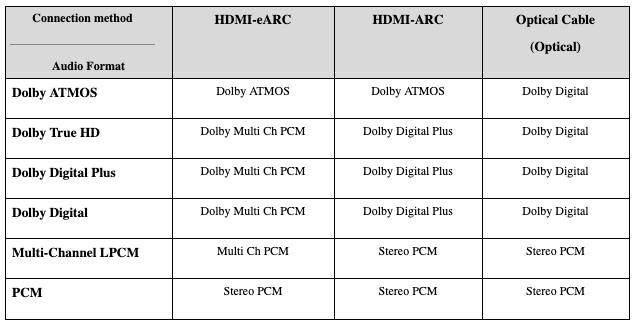Understanding the audio formats displayed on your Samsung soundbar

Soundbars play a crucial role in creating a home entertainment setup, allowing you to experience immersive sound that fills the room, just like in a movie theater. Your Samsung soundbar can be connected in several ways, including HDMI (eARC/ARC) and Bluetooth, which lets you enjoy audio without losing quality. For detailed connection methods, refer to our Samsung soundbar connection guide.
Notes:
- The display on the soundbar may not be supported depending on the soundbar model, connection method, or region.
- Depending on the software version of your soundbar, Dolby Multi Ch PCM may be displayed as Multi Ch PCM.
- When connected through Bluetooth, the soundbar supports SBC data (44.1kHz, 48kHz).
- When you set the TV’s optical output to "Simultaneous Optical Output" in the menu, the audio will be output in either PCM or Dolby Digital format.
Samsung soundbars support various audio formats, which may vary depending on the soundbar model and connection method. When connected to your Samsung TV, the soundbar's display may vary, depending on the connection method.

Refer to the table and the list below for information about audio format types:

- Dolby ATMOS: A 3D surround sound technology that provides immersive sound and envelopes the listener. This technology offers a revolutionary sense of depth and immersion in a home theater environment. Dolby Atmos is a flexible and scalable object-based format that reproduces audio as independent sounds (or objects) that can be dynamically positioned and moved in a 3D listening space during playback.
- Dolby TrueHD: A high-quality audio technology developed by Dolby Laboratories that uses lossless encoding to faithfully reproduce studio master sound. This format supports up to 8 audio channels with a sampling frequency of 96kHz/24-bit resolution and up to 6 channels with a sampling frequency of 192kHz/24-bit resolution.
- Dolby Digital Plus: An enhanced Dolby Digital signal format compatible with up to 7.1 channels, offering backward compatibility with traditional Dolby Digital. The increased data bit rate performance improves audio quality.
- Dolby Digital: A digital signal format developed by Dolby Laboratories that supports 5.1 channel audio. Dolby Digital compresses each channel separately, allowing each channel's sound to be played independently without interference.
- LPCM (Linear Pulse Code Modulation): One of the most fundamental codecs for digital audio, dedicated to uncompressed and lossless audio playback at 96kHz/24-bit.
- PCM (Pulse Code Modulation): A method for converting analog signals into digital signals. It is one of the most commonly used methods for storing or transmitting audio data, making it easier to process and store data.
Thank you for your feedback!
Please answer all questions.